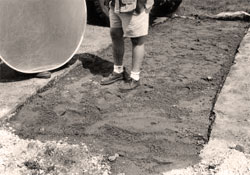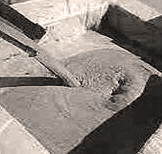Flowable Fill Offers Numerous Cost Advantages
Flowable fill is a controlled low-strength material made of cement, fly ash, water, sand, and typically an air-entraining admixture. This mixture is useful for backfilling utility trenches, mud jacking, pipe bedding, abandoned sewers, and many other applications.
 The City of Houston Department of Public Works and Engineering is saving taxpayers' money by using flowable fill for its backfilling needs. Although price per cubic yard of flowable fill is more expensive than other backfill materials, flowable fill proves to reduce in-place costs across the board. On one job recently in Houston, more than $12,000 was saved by using flowable fill, and this savings is not unusual. Use of the material is more cost-effective than regular backfill because it is nonsettling, self-leveling, quick-drying, nonsegregating, and easy to excavate.
The City of Houston Department of Public Works and Engineering is saving taxpayers' money by using flowable fill for its backfilling needs. Although price per cubic yard of flowable fill is more expensive than other backfill materials, flowable fill proves to reduce in-place costs across the board. On one job recently in Houston, more than $12,000 was saved by using flowable fill, and this savings is not unusual. Use of the material is more cost-effective than regular backfill because it is nonsettling, self-leveling, quick-drying, nonsegregating, and easy to excavate.
A major concern for public works directors is the amount of money spent on repetitive work. For instance, within the City of Houston, the street maintenance division must often return to a job site where the utility maintenance division previously made a repair and the road settled thereafter. Hence, within the same city, double work is being performed; therefore, double taxpayer money in that area is unnecessarily spent. A solution to that specific problem may be found by using flowable fill. Because it does not settle, the roadways above the backfill will stay in place.
Worker safety is improved
 Since flowable fill is self-leveling and quick-drying, a great amount of resources are also saved. And, more importantly, worker safety is not jeopardized due to trench failure. Only one operator is needed to dispense the material directly from the chute of a cement mixer into the cavity. In contrast to backfill using the conventional method, the backfill material is placed in 6-12 inch lifts and compacted using water, mechanical tampers, or by hand. Consequently, the regular procedure is time-consuming, labor-intensive, and puts workers at greater risk of injury. Because man hours are saved with flowable fill, money is not spent superfluously on dump trucks, backhoes, laborers (including traffic control), tamps, and so on.
Since flowable fill is self-leveling and quick-drying, a great amount of resources are also saved. And, more importantly, worker safety is not jeopardized due to trench failure. Only one operator is needed to dispense the material directly from the chute of a cement mixer into the cavity. In contrast to backfill using the conventional method, the backfill material is placed in 6-12 inch lifts and compacted using water, mechanical tampers, or by hand. Consequently, the regular procedure is time-consuming, labor-intensive, and puts workers at greater risk of injury. Because man hours are saved with flowable fill, money is not spent superfluously on dump trucks, backhoes, laborers (including traffic control), tamps, and so on.
Flowable fill offers far-reaching benefits
Additionally, flowable fill can be easily excavated in the future. Individual specifications on strength and density can be written on a per-job basis. Flowable fill can range anywhere from 25-2000 psi, depending on the recipe used. An average road has a reading of 4000 psi.
When writing specifications, a strength range of 75- 150 psi is a good place to start if the backfilling of trenches is planned. Because of this low but sturdy psi, the mixture can be dug out by hand if required at a later date without costly machines such as pavement breakers. The publication Concrete Information states, "Using unshrinkable (flowable) fill prolongs the riding quality and service life of the pavement, while providing easy access to the utility should repairs be required in the future."
 In addition, flowable fill will not segregate. Therefore, the material will not have varying strengths due to separating into different layers. With the important air-entraining additive, piping is less likely to shift or float, due to a uniform density throughout the material. Since flowable fill is a controlled-density backfill, water is easily dispersed, again enabling time to be saved. This translates into not having to pump water out of the trench before backfilling. In fact, a city engineer in Peoria, Illinois noted, "Probably the greatest benefit is the fact that this material was placed under slabs which had been washed out from a water leak." Since another step of pumping the trench dry before backfilling is saved, flowable fill continues save money.
In addition, flowable fill will not segregate. Therefore, the material will not have varying strengths due to separating into different layers. With the important air-entraining additive, piping is less likely to shift or float, due to a uniform density throughout the material. Since flowable fill is a controlled-density backfill, water is easily dispersed, again enabling time to be saved. This translates into not having to pump water out of the trench before backfilling. In fact, a city engineer in Peoria, Illinois noted, "Probably the greatest benefit is the fact that this material was placed under slabs which had been washed out from a water leak." Since another step of pumping the trench dry before backfilling is saved, flowable fill continues save money.
The City of Houston's public works department sees a final advantage in using flowable fill in that it enables the city to compete better with private contractors.


